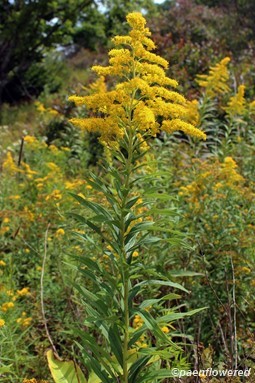Solidago altissima
Solidago altissima tall goldenrod
This species of goldenrod is one you are most likely to see along the roadsides. It is not easy to distinguish the many similar species of goldenrod, but there are clues you can look for. First, this species tends to be tall - 3 to 7 feet high. Second, this species generally has a graceful, plume-shaped flower cluster. Third, if you get closer, you will note that the leaves have a rough upper surface and are finely downy underneath. These leaves are lance-shaped with parallel veins, rather than the feather veins found in some goldenrod species. There are teeth on the leaf edges, but these are usually few and scattered. Finally, the stem is greenish or gray and also covered with tiny hairs.
The tall goldenrod grows throughout much of North America, mostly along roadsides, in open woods, thickets or in clearings. The individual flower heads that make up the cluster are fairly typical of many goldenrod species, but tend to be fairly small - about 1/8 inch in diameter. It blooms from August to November. Genetically the species is quite complex, with populations of plants with 2, 4 or 6 sets of chromosomes. Although not precise, there are often considered eastern and western subspecies of tall goldenrod.
There has been a recent trend among botanists to classify the tall goldenrod as a variety of the Canada goldenrod (S. canadensis). I have doubts about this because there are more distinct teeth on the Canada goldenrod leaves. Canada goldenrod also tends to bloom much earlier in the season. Tall goldenrod is easily mistaken for the late goldenrod (S. gigantea) that has smooth stems. Both species bloom about the same time and have many traits in common.
Habitat & Range
Common in open woods, fields, along roadsides.
Present throughout the state.
| EMP: | FACU |
|---|---|
| NCNE: | FACU |
Phenology
Flowers July through November.
Plant Codes
S-rank: No rank
G-rank: G5 (Secure)












Comments
Have you spotted this plant in your area? We'd love to hear about your experience! Share your comments or questions about the plant below. Comments are moderated before posting.